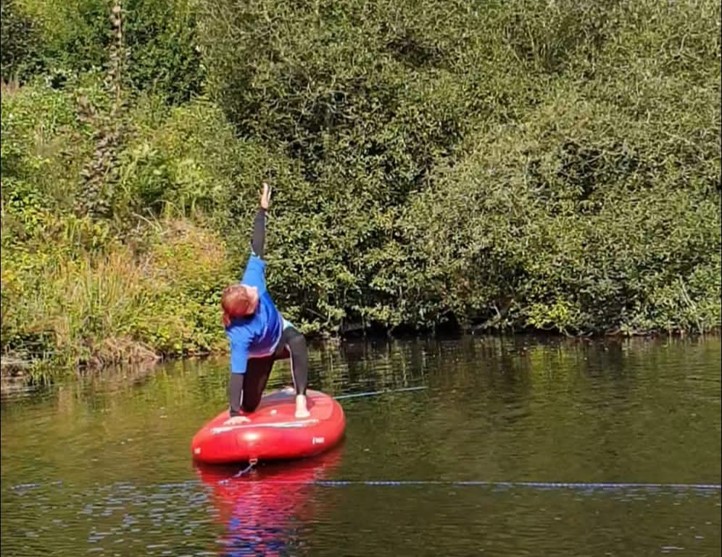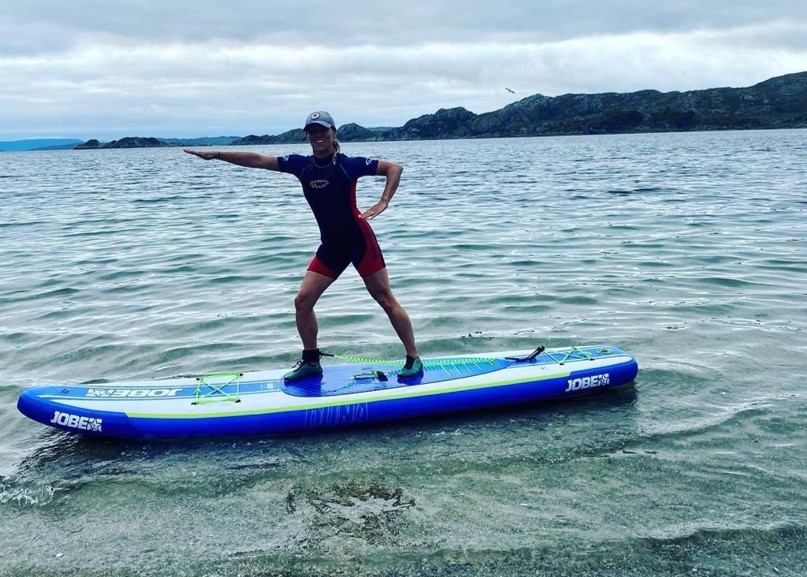Paddleboarding is fantastic fun and adventure it’s true. But more than that, it can also be included as part of your fitness & well-being regime.
Consider the beauty of the locations visited and (hopefully) the tranquillity of the lake, ocean, & mountain surroundings when you are out on your paddleboard adventures. Does this not all add up to a perfect setting for an outdoor yoga class?
Indeed it does. With all the focus on the importance of mental health as well as physical, not only Yoga, but Pilates and meditation can all be practiced and enjoyed from the tranquil settings of a SUP on any body of still water.
The things to bring along to any paddleboard Yoga trip would include a stable paddleboard (essential), appropriate clothing depending on the weather conditions, a light snack, a water bottle for hydration, sunscreen if needed, and a set of dry clothes should you fall into the drink! That said, here is a more detailed list of the things above, that you may need on any SUP Yoga outing.

- A stable paddleboard: Paddle boards come in a variety shapes and sizes depending on the use that they may be put to. This can be anything from general leisure activities to full-on white water rafting. A good board for Yoga however does not have to be anything special, just a board that is stable in itself (usually a broader 34” wide design) or indeed one that you are comfortable with and are able to practice your Yoga poses without. The thickness of the board is also important – especially for the inflatable type. A 6 inch thick board (150mm) is recommended as it is less likely to ‘taco’ in the middle and flex as you are trying to strike a position.
- Appropriate clothing: It is always advisable or even a legal requirement in some places, to wear a personal flotation device (PFD). When choosing a PFD for yoga then be sure that it is not obtrusive and that you can move without hindrance. If you are in a warmer climate such as California then you can choose light over-garments such as swimsuits or bikinis, however in colder Northern climates or just over colder periods, then a wetsuit (or drysuit) is a good idea. If you do fall in it will offer you protection against the cold – and jellyfish! Cotton garments are not advisable as they will soak up any water and become wet & heavy. As for boots or shoes, most folks like to remove them during Yoga sessions as your bare feet will get a better grip of the board than rubber-soled shoes will.
- Food and water: Before any outdoor adventure it is usually advisable to have a light snack – not a full-blown sit-down meal mind! Before your Yoga practice it is best to have a snack such as an energy bar beforehand. Getting light-headed owing to hunger is not a good idea in the middle of the water! Likewise with hydration. Make sure you are well hydrated and drink plenty of water before heading out, especially if you are in warmer weather. Ok, so you might have to pee more than is comfortable! Better that though than becoming dehydrated and ill as a consequence. Been there, done that, not at all pleasant!
- Protection for the sun: Just like if you are on holiday lying on a beach somewhere hot, the glare from the sun can soon burn you up – even on a cloudy day. More dangerous still if there is a light breeze that may make you feel cool. Wearing a decent sunscreen is often forgotten about when out on a paddleboard, but is can be a real life saver on a prolonged trip especially. Strolling along on your SUP or doing your Yoga routine, you can easy not notice time slipping by – and the skin burning under a hot sun. Be cool, not a fool, and follow the golden rule – apply regularly, especially in or near water.
- Dry clothing: It’s always best practice to carry a dry set of clothing when you are out on the water – for obvious reasons. It is really no fun travelling back home at night in wet pants & socks! Make a habit of keeping a spare set of dry clothes in the car in case of emergency. Also remember to bring along a good warm beach towel to dry yourself down after a session on the water.
- Bug Spray! On inland waterways and lakes, mosquitos or midges can make your life a misery! This is not only uncomfortable but the action of slapping away mosses can ruin your SUP yoga Experience and maybe result in tipping yourself overboard
 ! Make sure you pack some good bug deterrent before heading outdoors.
! Make sure you pack some good bug deterrent before heading outdoors.

Things to leave at home when going Paddleboarding would include any valuables you do not want lost at the bottom of the water! This would include mobile phones, watches, rings, ear-rings, necklaces amulets, and anything else that plays no part in your SUP Yoga session.
Alternatively you can place them in a waterproof bag or fanny pack and make sure they are firmly secured either on the Paddleboard or on your person. Car keys I would definitely leave with someone ashore, or pack securely in a waterproof bag with me.
Still I think it’s best to practice a bit of ‘Jewellery minimalism’ when on an SUP.

Yoga SUP Summary:
Overall the actual products you need to bring to a SUP Yoga session do not vary a great deal from what you would bring to any other outing on a Paddleboard, perhaps with the exception of some clothing.
Another addition would be your state of mind, or mental preparedness. Planning ahead and emptying your mind from any stressful or worrisome thoughts will all help with the actual Yoga session.
Yoga after-all is all about physical exercise coupled with mental focus to help relieve your body of the stress involved in everyday life.
The Merriam-Webster definition would seem to fit… “a system of physical postures, breathing techniques, and sometimes meditation derived from Yoga but often practiced independently especially in Western cultures to promote physical and emotional well-being”
Enjoy!
Recent Posts
Our latest Paddleboard adventure comes mainly thanks to driftwoodadventures! They kindly arranged the whole thing for us - which is important to us especially, as we were not sure of the...
What Fitness Level Do I Need For Stand Up Paddleboarding (SUP)?
Stand-Up Paddleboarding (SUP) is a fantastic water sport that has grown significantly in popularity in recent years. It's a fun and accessible activity that allows you to enjoy the outdoors and get...
